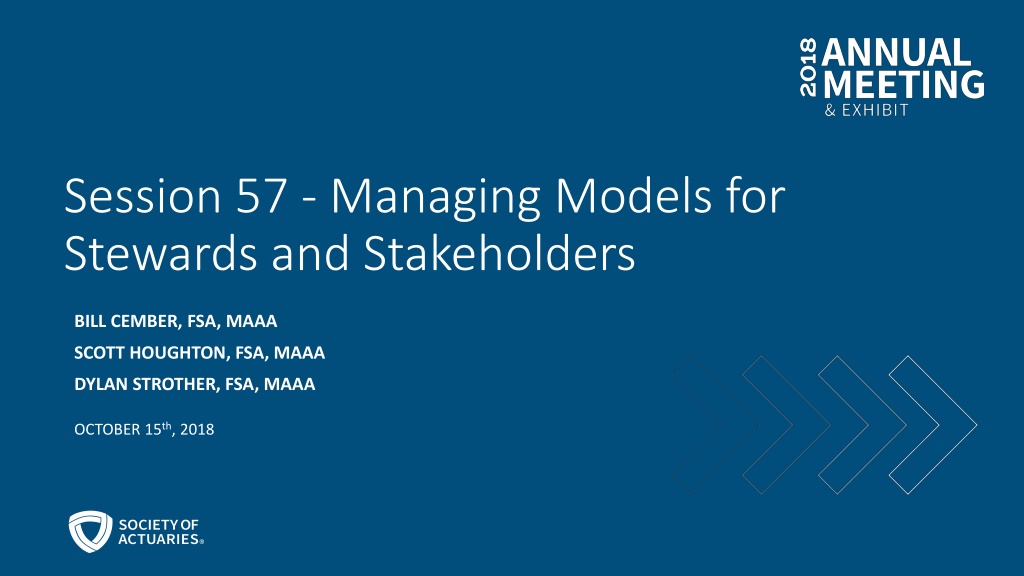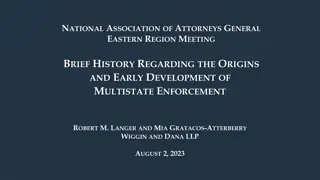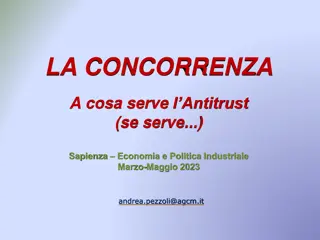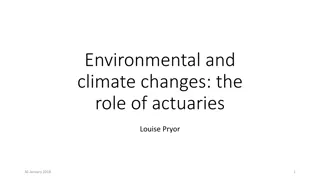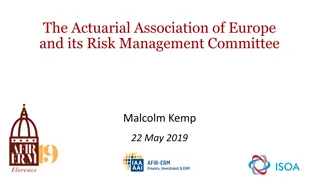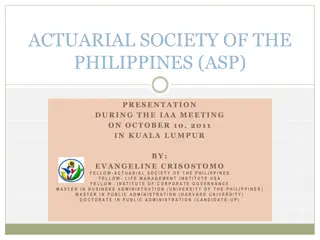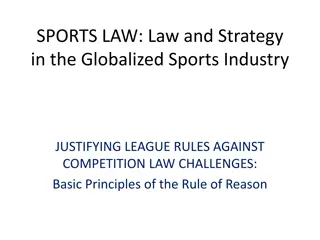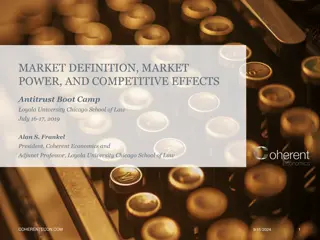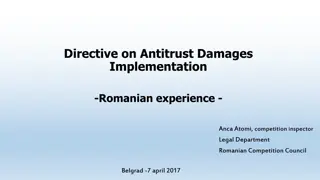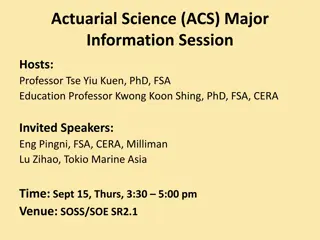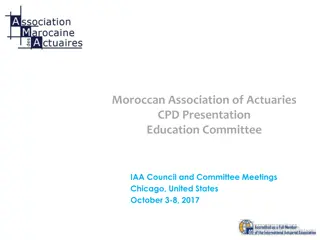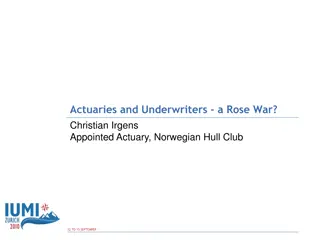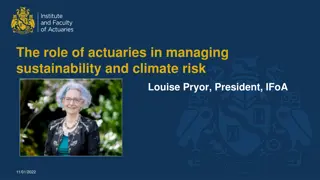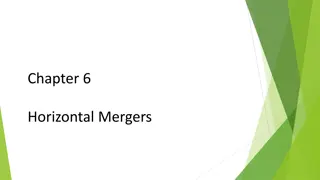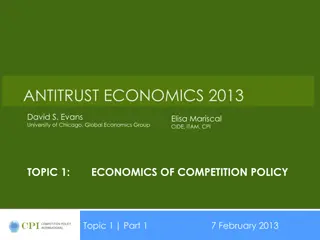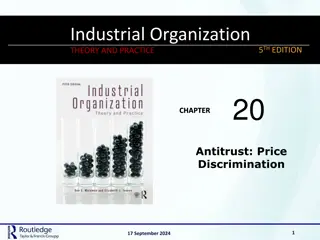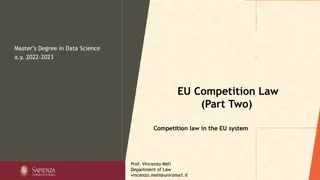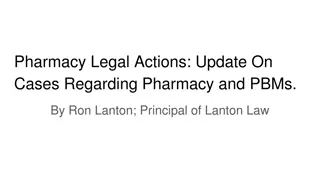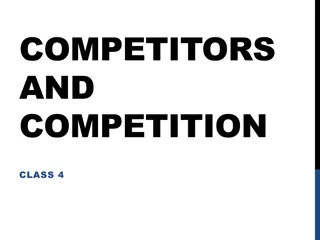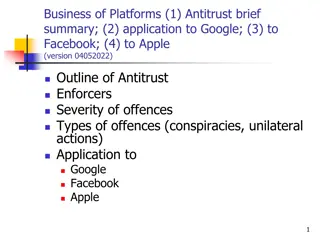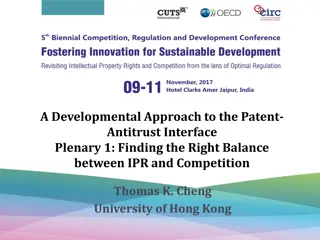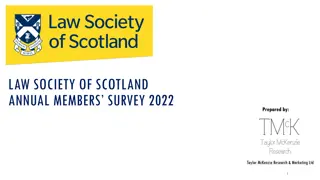Antitrust Compliance Guidelines for Society of Actuaries Members
Guidelines for active participation in the Society of Actuaries, ensuring compliance with antitrust laws to avoid anti-competitive behavior during association activities. The guidelines emphasize avoiding discussions on sensitive topics like pricing, market allocations, and trade conditions to prevent potential violations and protect the interests of members and the SOA.
- Antitrust Compliance
- Society of Actuaries
- Professional Guidelines
- Competition Protection
- Association Activities
Download Presentation

Please find below an Image/Link to download the presentation.
The content on the website is provided AS IS for your information and personal use only. It may not be sold, licensed, or shared on other websites without obtaining consent from the author. Download presentation by click this link. If you encounter any issues during the download, it is possible that the publisher has removed the file from their server.
E N D
Presentation Transcript
Session 57 - Managing Models for Stewards and Stakeholders BILL CEMBER, FSA, MAAA SCOTT HOUGHTON, FSA, MAAA DYLAN STROTHER, FSA, MAAA OCTOBER 15th, 2018
SOCIETY OF ACTUARIES Antitrust Compliance Guidelines Active participation in the Society of Actuaries is an important aspect of membership. While the positive contributions of professional societies and associations are well-recognized and encouraged, association activities are vulnerable to close antitrust scrutiny. By their very nature, associations bring together industry competitors and other market participants. The United States antitrust laws aim to protect consumers by preserving the free economy and prohibiting anti-competitive business practices; they promote competition. There are both state and federal antitrust laws, although state antitrust laws closely follow federal law. The Sherman Act, is the primary U.S. antitrust law pertaining to association activities. The Sherman Act prohibits every contract, combination or conspiracy that places an unreasonable restraint on trade. There are, however, some activities that are illegal under all circumstances, such as price fixing, market allocation and collusive bidding. There is no safe harbor under the antitrust law for professional association activities. Therefore, association meeting participants should refrain from discussing any activity that could potentially be construed as having an anti-competitive effect. Discussions relating to product or service pricing, market allocations, membership restrictions, product standardization or other conditions on trade could arguably be perceived as a restraint on trade and may expose the SOA and its members to antitrust enforcement procedures. While participating in all SOA in person meetings, webinars, teleconferences or side discussions, you should avoid discussing competitively sensitive information with competitors and follow these guidelines: Do not Do not discuss prices for services or products or anything else that might affect prices Do not Do not discuss what you or other entities plan to do in a particular geographic or product markets or with particular customers. Do not Do not speak on behalf of the SOA or any of its committees unless specifically authorized to do so. Do Doleave a meeting where any anticompetitive pricing or market allocation discussion occurs. Do Doalert SOA staff and/or legal counsel to any concerning discussions Do Doconsult with legal counsel before raising any matter or making a statement that may involve competitively sensitive information. Adherence to these guidelines involves not only avoidance of antitrust violations, but avoidance of behavior which might be so construed. These guidelines only provide an overview of prohibited activities. SOA legal counsel reviews meeting agenda and materials as deemed appropriate and any discussion that departs from the formal agenda should be scrutinized carefully. Antitrust compliance is everyone s responsibility; however, please seek legal counsel if you have any questions or concerns. 2
Presentation Disclaimer Presentations are intended for educational purposes only and do not replace independent professional judgment. Statements of fact and opinions expressed are those of the participants individually and, unless expressly stated to the contrary, are not the opinion or position of the Society of Actuaries, its cosponsors or its committees. The Society of Actuaries does not endorse or approve, and assumes no responsibility for, the content, accuracy or completeness of the information presented. Attendees should note that the sessions are audio-recorded and may be published in various media, including print, audio and video formats without further notice. 3
Introductions Introductions Bill Cember Bill Cember is an actuary at Prudential where he is responsible for model development on interest sensitive life projections. Prior to Prudential, he worked in a variety of roles including at a large multinational insurer and as a consultant. Most recently, he saw things worked "on the other side," working as a modeler at a large global macro hedge fund. Bill is a Fellow of the Society of Actuaries and member of the American Academy of Actuaries. Scott Houghton Scott Houghton Dylan Strother Dylan Strother is a manager in Consulting Services practice at the PolySystems Chicago office. He is rooted in statutory & GAAP financial reporting and valuation across a variety of products. He has played an integral part in actuarial modernization, modeling, and model validation consulting projects throughout his career. He has prior experience as a consultant and auditor at a big four auditing firm as well as at a major insurance carrier. 5
To Participate, look for Polls in the SOA Event App or visit annual.cnf.io in your browser Find The Polls Feature Under More In The Event App More Type annual.cnf.io annual.cnf.io In Your Browser or 6
Agenda Agenda 1 Changing environment for models 2 Efficient model design techniques 3 Model governance & stakeholders 4 Managing model risk Making models better 5 6 Communicating results effectively 9
Whats Up With Models? What s Up With Models? Regulation and accounting is changing Regulation and accounting is changing Also acceptable: regulation has changed, regulation will change again VM 20 IFRS 17 GAAP TI QIS Regulation and accounting changes have implications on models, shifting towards: Regulation and accounting changes have implications on models, shifting towards: Increasingly more complex projection models Sometimes with corresponding complex asset models And assumptions that are updated frequently and require judgement Moving away from simplified models and formulaic calculations 11
Whats Up With Models? What s Up With Models? Who cares about increased complexity? Who cares about increased complexity? Actuaries who maintain models Modeling Actuaries Valuation Actuaries Or, newly appointed model stewards, which could be any of the above Management Auditors Regulators Why? Why? Model requirements are evolving, becoming more complex while demanding increased precision, not just a tool that provides ranges and distributions The results of complex projection models with lots of stuff in them are now directly impacting the financial statements 12
What does it mean? What does it mean? An Implication An Implication The risk inherent within models is extending to the financial statements, increasing scrutiny of Data and methods used to develop assumptions and margins Use of judgement to determine assumptions Interpretation of guidance and translation into mechanical calculations Errors in the calculation coding or engine 13
Risk is Opportunity Risk is Opportunity Model Management Model Management Higher scrutiny drives the need for model management, especially: controls over the model, internal consistency, internal efficiency and transparency of models A key component of communicating results is being able to rely on effective processes An opportunity to rethink the process for different types of models An opportunity to rethink the process for different types of models Actuarial Financial Models Period end reporting / financial statement build process Target Operating Model / Resourcing Models 14
Actuarial & Reporting Models Actuarial & Reporting Models So why is now a good opportunity to increase attention of model management? So why is now a good opportunity to increase attention of model management? Complex cashflow projections have arrived in the valuation of traditional life insurance products Just about every set of financial reporting basis has a major change coming soon Product design is increasingly more complex, the industry continues to evolve Technology continues to improve, which in turn increases demand for detailed results 15
Resource Models Resource Models Actuarial and Finance departments may take rethink how they are organized and Actuarial and Finance departments may take rethink how they are organized and how they mitigate risk in processes, including new roles: how they mitigate risk in processes, including new roles: Model Steward Senior Mgmt Model Steward? Qualified Actuary Valuation Modeling Pricing May need to leverage experienced modelers in valuation roles Having the right people to explain model output to management 16
Havent I heard about this before? Haven t I heard about this before? This isn t news to me This isn t news to me I m a valuation actuary that has been working with complex models and using them to produce financial statement values since before you were born Anonymous What makes it different from managing models used for modeling or pricing? What makes it different from managing models used for modeling or pricing? Completeness and accuracy of input data Documentation requirement is significantly greater and relied upon more (SOX, MAR, VM-31, GAAP disclosures) What is the training process to ensure developers, reviewers, stewards, and end- users are adequately knowledgeable of model usage and processes? Implication Implication Much of finance can benefit from more formalized, better model management 17
Model Ste Model Ste- -what? what? Model Steward Model Steward Responsible for governance of change control process and model development lifecycle There isn t a single definition of this role that fits all actuarial departments at all There isn t a single definition of this role that fits all actuarial departments at all companies. Primary roles for stewards: companies. Primary roles for stewards: Drive consistency, cross-functionality and efficiency in model development / usage through model design framework and modeling standards Implementing the model governance framework in design and processing, managing the model uses, users and user training, and life cycle of the model Reducing model risk through well designed processes, controls, and validation May also be a key contributor to documenting the functions and use of models and therefore a useful resource in communicating results to stakeholders 18
Model Design Discussion Items 1. 1. What is a model anyway and how do we use it? Model Components & Use Model Components & Use- -Cases Cases 2. 2. Example models and their components Toy Models Toy Models 3. 3. Build once, leverage across (or why not) Modularity & Model Consolidation Modularity & Model Consolidation 20
Model Design Model Components & Use-Cases Actuarial models are made of lots of stuff Many different use- cases of actuarial models Some components can be shared across use-case, others unique Component Component Component type Component type Liability inforce Input Asset portfolio Input Liability assumptions Input Asset & reinvestment assumptions Input Statutory & tax reserves Calculation Engine Economic reserves & embedded value Calculation Engine GAAP Calculation Engine Cashflow projections Calculation Engine Capital Calculation Engine Reports Output 21
Model Design Model Components & Use-Cases Increasingly, calculations are getting more complicated Portions of a model can often be shared across use-case Is it always appropriate to share components? Component Component Primary Use Primary Use- -Case Case Additional Use Additional Use- -Cases Cases Statutory reserves Valuation (Statutory reporting) Pricing Projections (cashflow testing, forecasting) GAAP Valuation (GAAP reporting) Pricing Projections Cashflow projections Projections Pricing Valuation (PBR, AG48) Assets & reinvestments Cashflow testing Valuation (PBR, AG48) Pricing Liability inforce Everything but pricing Liability & asset assumptions Everything but formulaic reserves 22
Model Design Toy Models - Generic Model Inputs Capital & Economic Reserves Assets Reinvestments Projection Formulaic Reserves (Stat) GAAP Balances Liability Cashflows Outputs 23
Model Design Toy Models - Statutory Valuation (Formulaic) Inputs Capital & Economic Reserves Assets Reinvestments Projection Formulaic Reserves (Stat) GAAP Balances Liability Cashflows Outputs 24
Model Design Toy Models - Cashflow Testing Inputs Capital & Economic Reserves Assets Reinvestments Projection Formulaic Reserves (Stat) GAAP Balances Liability Cashflows Outputs 25
Model Design Toy Models - Forecasting Inputs Capital & Economic Reserves Assets Reinvestments Projection Formulaic Reserves (Stat) GAAP Balances Liability Cashflows Outputs 26
Model Design Modularity & Model Consolidation Modularity - Building your model using reusable building blocks - When used correctly, can have great benefit to the company do once, leverage across Examples - Create a consistent and controlled way to run model - Establish a well-defined structure for various components - Utilize scripts to call and parameterize different components by purpose - Standardize naming conventions to differentiate by business purpose 27
Model Design Modularity & Model Consolidation Design Consideration Design Consideration Advantages of Model Consolidation Advantages of Model Consolidation Disadvantages of Model Consolidation Disadvantages of Model Consolidation One source of truth One model or model component can force consistency -Getting buy-in from multiple stakeholders -Consistency not always desirable -Technological limitations Avoid repeating work One model avoids situation where multiple teams doing repeated work Getting buy-in from multiple stakeholders Flexibility Consolidate models with similar flexibility requirements Different use-cases have different requirements for flexibility. E.g. pricing versus valuation Controls Consolidate model with similar control requirements Different use-cases have different requirements for controls. E.g. pricing versus valuation Training Modular approach can streamline training and transition across teams 28
Governance & Stakeholders Discussion Items 1. 1. Who needs to get involved with the model anyway? Stakeholders Stakeholders 2. 2. What is everyone supposed to do? Roles & Responsibilities Roles & Responsibilities 3. 3. How are we going to do it? Model Development Life Cycle Model Development Life Cycle 30
Governance & Stakeholders Stakeholders Traditional Approach Team Structure Team Structure - Each team separately managing their own model MDLC MDLC - Formal model development lifecycle (MDLC) not necessarily followed Roles & Responsibilities Roles & Responsibilities Informal role distinction. One person, multiple hats Model Steward Model Steward - Model steward role not necessarily used Decision Making Decision Making - Team lead can make modeling decisions largely in a silo Prioritization Prioritization Less of a need for a formal prioritization process. Stakeholders not competing for model development resources Model Governance Model Governance Centralized model governance group often setting standards 31
Governance & Stakeholders Stakeholders One Model Approach Team Structure Team Structure Centralized model development group MDLC MDLC - Formal MDLC needs to be followed given many stakeholders Roles & Responsibilities Roles & Responsibilities Formal role distinction. E.g. Developer, tester, user, and steward Model Steward Model Steward - Model steward role key Decision Making Decision Making Many stakeholders affected by decisions. Formal decision making process likely needed given number of stakeholders Prioritization Prioritization Many stakeholders asking for model changes and enhancements. Formal prioritization process likely needed Model Governance Model Governance Centralized model governance group often setting standards 32
Governance & Stakeholders Roles & Responsibilities Role Role Description Description Developer Responsible for coding the model according to requirements. Works with users to understand requirements and communicate necessary model simplifications Tester Responsible for testing model against requirements. Unique person from developer. Communicates testing findings to developer. Steward Responsible for governance of the change control process and model development lifecycle User Uses model for intended purpose (e.g. reporting, analysis). Provides requirements for new changes to model developer. Owner Accountable for overall model. Example roles and responsibilities for model development. In addition to the roles & responsibilities themselves, both a strong model governance function, making sure the requisite checks and balances are occurring, and project management are important. 33
Governance & Stakeholders Roles & Responsibilities Benefits of well-defined roles & responsibilities Promote accountability Create efficiencies Avoid silos Encourage talent mobility Challenges with formal role distinction Actuaries want to do everything Things in the gray zone who does it? Missing the big picture 34
Governance & Stakeholders Simplified Model Development Life Cycle Request & Prioritize Design Develop Test Release Model Governance Developer X X X Tester X X Steward X X X X X User X X X X Requirements Design Sandbox model Testing artifacts Production model blueprints Project Management 35
Governance & Stakeholders Takeaways Well-defined roles & responsibilities useful whether centralized or localized modeling team The degree to which formal role distinction is needed is dependent on your company s goals and specific needs; advantages and disadvantages of centralized modeling team Role distinction requires even greater communication! Formal procedures are not sufficient your actuaries need to talk to each other It s always possible to do more. Use a risk-based approach for governance, and prioritize model changes with what s most impactful Too many cooks spoil the broth; if shared model components, set clear decision makers and accountability 36
How stewards can manage model risk (1/3) Keep model documentation updated Business requirements Functional and other requirements Users, uses, and stakeholders Input dependencies Output requirements Model procedures Model uses and limitations Understand and document model approximations 38
How stewards can manage model risk (2/3) Understand model design Understand choices made when model was created Understand limitations of model created by choices Ensure model specifications understood Confirm model coding consistent with specifications 39
How stewards can manage model risk (3/3) Ensure controls and current and effective Validate data and model input Formal or informal controls to tie model statistics to source Promote understanding of model output 40
How stewards and stakeholders can make models better
How stewards and stakeholders can make models better (1/2) Keep and prioritize a day 2 list New and upcoming business requirements New regulations/regulatory requirements Items and functionality desired but not currently in model Functionality to model new and upcoming products New / potentially improved IT processes Remove approximations (when appropriate) 42
How stewards and stakeholders can make models better (2/2) Allow models to evolve with stakeholder needs Consider model life cycle to allocate resources appropriately Suitability of current platform to support future requirements 43
Communication of results - model output Understand model output and limitations Document users and intended uses Address known limitations Communicate limitations to stakeholders Develop output based on stakeholder needs 45
Effective communication of results Focus on conclusions of analysis Focus on conclusions, but include detail of process Use charts, diagrams, and pictures when practical Use executive summary, detail, appendix 46
Communication of results example 1 Traditional 401(k) plans are funded with pre-tax contributions. Earnings are tax deferred. Contributions and earnings are taxed as ordinary income on withdrawal. Non-qualified distributions under age 59 may have additional 10% penalty tax. Roth 401(k) plans are funded with after tax contributions. Earnings are tax deferred. Contributions can be withdrawn tax free. Qualified distributions of earnings (over age 59 with plan contributions for 5 years) can be withdrawn tax free. Non- qualified distributions have earnings taxed and may have additional 10% penalty tax. Rules above are simplified for presentation purposes 47
Communication of results example 1 Traditional 401(k) Traditional 401(k) Roth 401(k) Roth 401(k) Contributions Pre tax dollars After tax dollars Earnings Tax deferred Tax deferred Qualification criteria Age 59 * Age 59 and contributions for at least 5 years* Qualified: ordinary income. Non qualified: ordinary income + penalty All tax free Tax treatment for withdrawals of contributions Qualified: ordinary income. Non qualified: ordinary income + penalty Qualified: tax free. Non qualified: ordinary income + penalty Tax treatment for withdrawals of earnings * Other criteria exist. Rules above simplified for presentation purposes 48
Communication of results example 2 Plotting bond yields by maturity and credit rating indicates that most yields fit in reasonable ranges. There are some outliers that require additional research. 49
